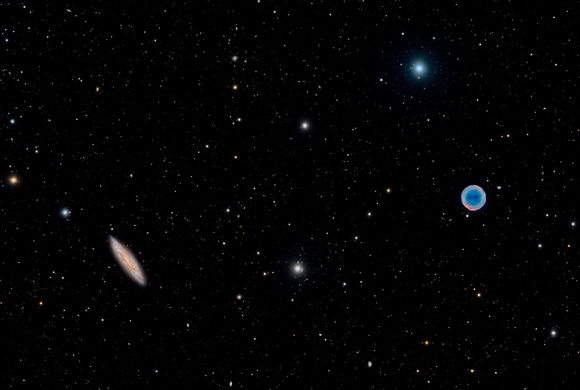M97 PN, M108 Galaxy and Many Friends in a NB / BB Combo
M97 (Owl Planetary Nebula) & (M108 Surfboard Galaxy) (Ursa Major) , Narrowband/Broadband Filter Combo, April 2023
Televue 127is telescope and A-P Mach2 mount
ASI6200MM Camera, Baader BB & 6.5nm NB Filters
RGB (3 x 20 x 120s exposures, Bin 1x1 Gain 100)
HOS (3 x 19 x 600s exposures, Bin 1x1, Gain100)
Total Integration Time = 11.5 hours
Two Messiers in one image. The galaxy begged RGB with possible Ha filters, but planetary nebulae show up best with narrow-band images. My solution was to shoot both narrowband and broadband, and combine by taking the maximum contribution to each broadband channel by each narrowband / broadband filter. The biggest hurdles were managing colour saturation during image stretches, and managing noise.
M97, the Owl Nebula, is a beautiful planetary nebula, with its bluish white-dwarf visible in the centre. It is the result of a sun-like star going novae about 8000 years ago. The ejected gases from the supernovae emit visible light by being bombarded by UV radiation from the planet sized white dwarf star.
M108, the Surfboard Galaxy, is a barred spiral with "loosely wound" spiral arms. It contain "supershells" of gas ejected from the spiral plane by past supernovae, and also contains multiple strong X-ray sources.
While M97 is a fairly close neighbour at 2,000 light-years distant, M108 is 40 Million lightyears away.


